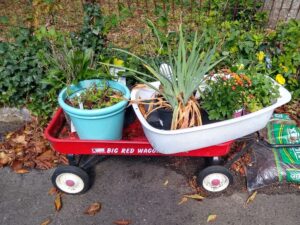
Previous generations had no “second season”, just as they never experienced the Halloween industrial complex or the curse of perpetual screen time. Fall used to be a leisurely affair that included harvesting whatever was left in the vegetable garden and replacing the fading pots of annuals by the front door with plump chrysanthemums. It also meant bulb buying and installation, not to mention fall garden clean-up—at least for the more virtuous gardeners.
But things have changed. Merchandisers have realized that in many parts of the country there are enough weeks of temperate weather left to make it possible to plant perennials and some shrubs, setting up the beds and borders for better displays next spring and summer. The range of fall-blooming perennials and annuals has expanded, giving mums a run for their money in the burgeoning second season garden sweepstakes.
The second season is both a blessing and a curse. It comes at a time when the pace of life picks up after summer vacations and recreation. Combine that with the diminishing number of daylight hours, and it becomes harder and harder to find the time necessary to plant those asters, boltonia, pansies and fall-blooming anemones that are positioned so alluringly on garden center pallets. Guilt can set in and sap your gardening resolve like aphids on a rosebush. The time crunch can mean that those bags of bulbs will languish in the garage, waiting for that moment in November or December when fear of hard frost triumphs over visions of artistry, and desperation forces you to fling small bulbs at random into large holes.
But the second season is not all about high anxiety punctuated by stolen moments of garden bliss. It can also hold unalloyed pleasure.
The easing of scorching summer temperatures makes just about any garden chore more pleasant. The big jobs, like major pruning, shrub planting and lawn mowing seem to go faster when less sweating is involved. Container garden maintenance chores ease up, because less water is required for potted specimens that threatened to perish daily in the summer heat.
Plant growth in autumn is less frantic than in spring, when everything pops out at once and proceeds to sprout up at warp speed. Even the weeds slow down—just a little. There may be less light in the day, but the quality of the light is wonderful. Even dandelions look better in golden October light.
You also get a second chance to plant any of those spring purchases that have languished in your holding area all summer, requiring constant watering and inspiring constant guilt.
Since merchandisers have capitalized on the second season, the best thing to do is embrace it. You can multi-task at the garden center by buying spring-flowering bulbs and new perennials at the same time. Invest in some additional mulch while you are at it.
Once you get those new plants home, though, it is wise to remember that time is at a premium. The second season is relatively short. Be conscious of the first frost date for your area and plan to get new plants in well ahead of the date. The Old Farmer’s Almanac at https://www.almanac.com/gardening/frostdates can help you find that very important milestone. Torrid heat may be less in fall, but new plants still need water regularly. Mulch around your new arrivals to help keep moisture in the soil.
Prioritize planting over other chores, like pruning, bulb installation and clean-up. If you, like me, have some spring or summer purchases hanging around, install those first.
Multi-task when you can, doing things like putting in new plants or bulbs while you are removing spent annuals.
And always remember that if your gardening energy has flagged after the labors of spring and summer, it is perfectly fine to ignore the siren song of the second season and simply emulate our forbearers by plopping those mums in the pots by the door and relaxing with a glass of cider or something stronger. Gardens fertilized with guilt and exhaustion will never do as well as those tended with renewed energy and enthusiasm.
